Organisational Behaviour: Culture, Power, and Motivation
VerifiedAdded on 2023/01/19
|16
|5199
|57
AI Summary
This study material explores the concepts of organisational culture, power, and motivation. It discusses different cultural dimensions, power dynamics, and motivational theories and techniques. It also provides insights into Waitrose's organisational culture and its impact on team performance. Additionally, it highlights the importance of motivation in employee engagement and productivity.
Contribute Materials
Your contribution can guide someone’s learning journey. Share your
documents today.
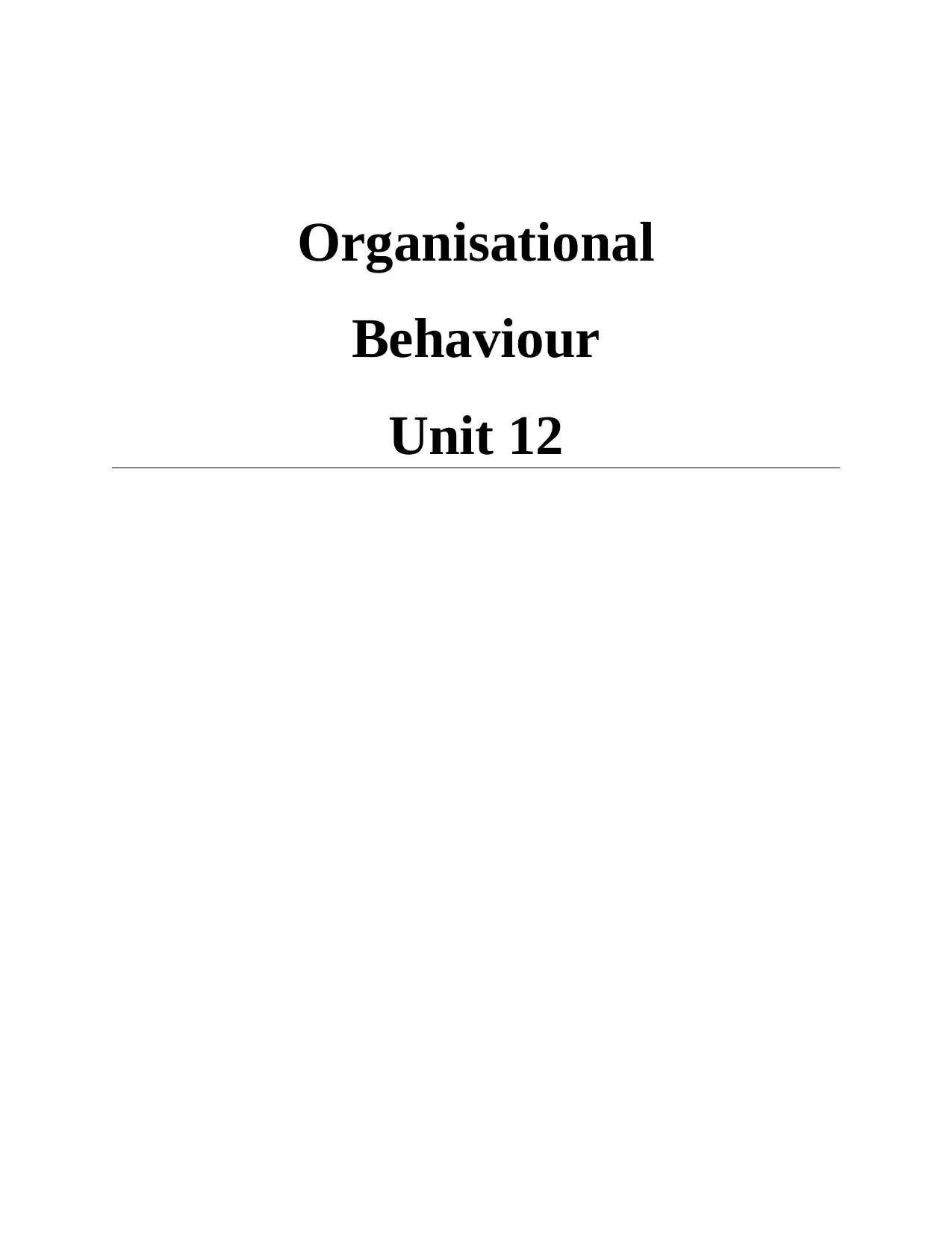
Organisational
Behaviour
Unit 12
Behaviour
Unit 12
Secure Best Marks with AI Grader
Need help grading? Try our AI Grader for instant feedback on your assignments.
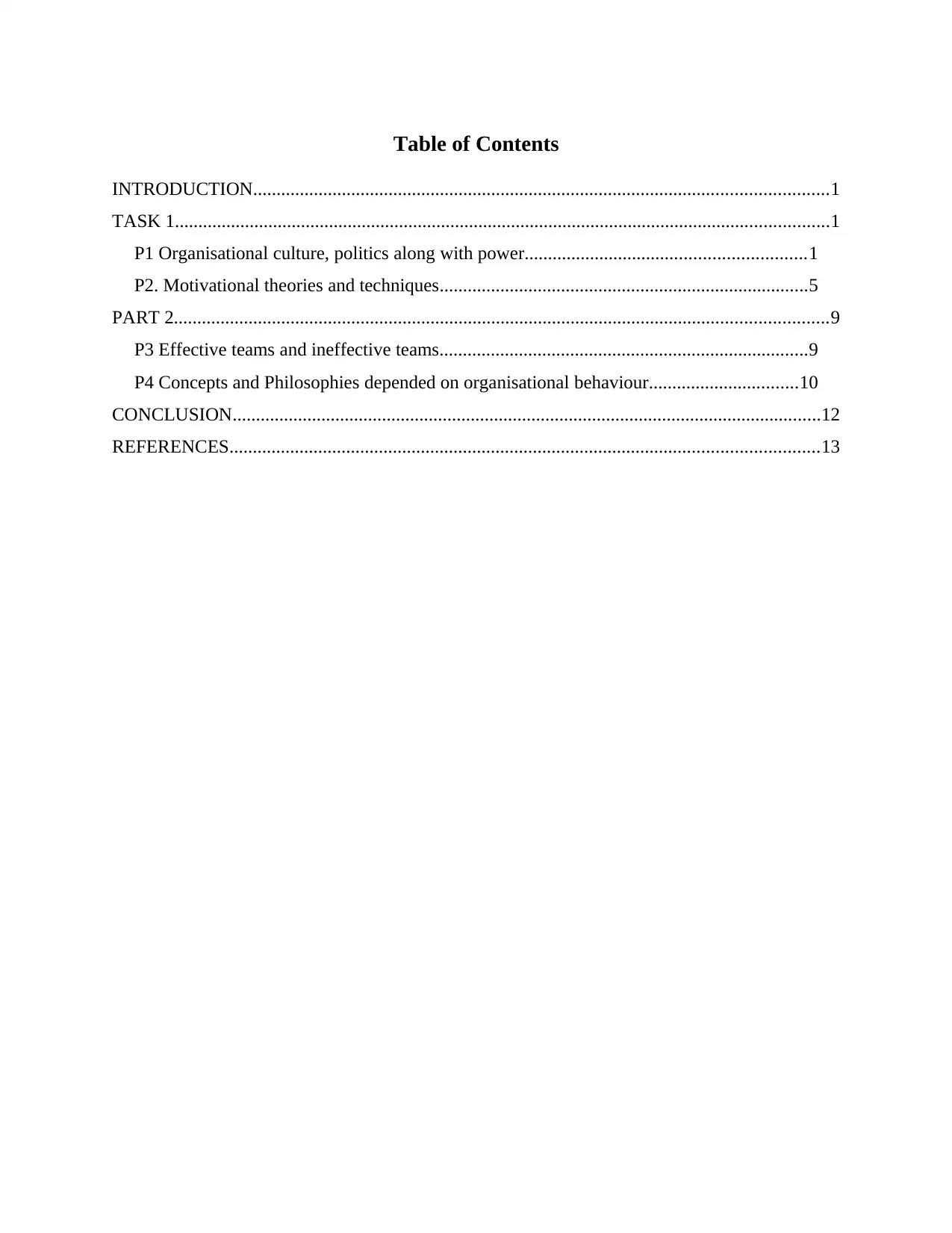
Table of Contents
INTRODUCTION...........................................................................................................................1
TASK 1............................................................................................................................................1
P1 Organisational culture, politics along with power............................................................1
P2. Motivational theories and techniques...............................................................................5
PART 2............................................................................................................................................9
P3 Effective teams and ineffective teams...............................................................................9
P4 Concepts and Philosophies depended on organisational behaviour................................10
CONCLUSION..............................................................................................................................12
REFERENCES..............................................................................................................................13
INTRODUCTION...........................................................................................................................1
TASK 1............................................................................................................................................1
P1 Organisational culture, politics along with power............................................................1
P2. Motivational theories and techniques...............................................................................5
PART 2............................................................................................................................................9
P3 Effective teams and ineffective teams...............................................................................9
P4 Concepts and Philosophies depended on organisational behaviour................................10
CONCLUSION..............................................................................................................................12
REFERENCES..............................................................................................................................13
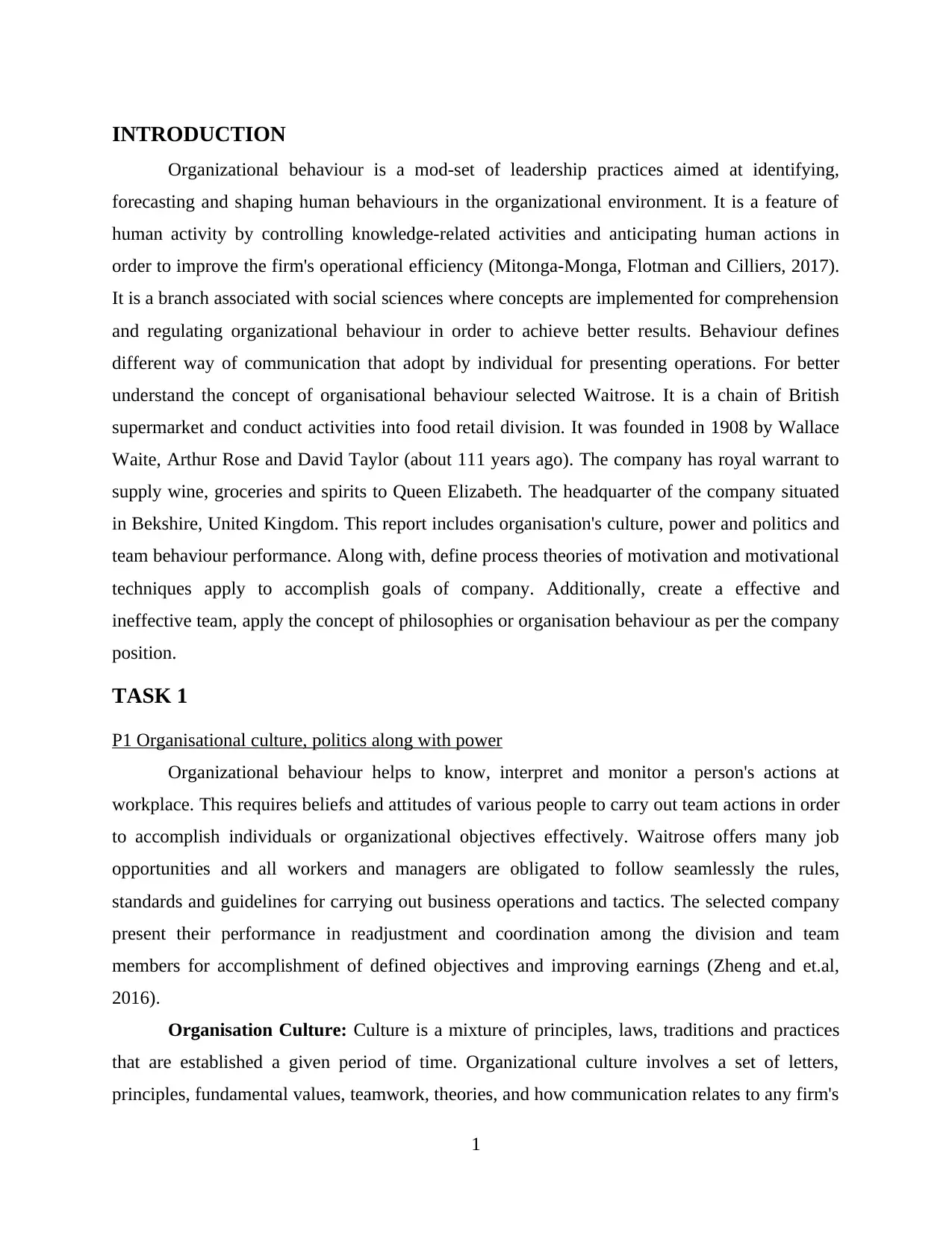
INTRODUCTION
Organizational behaviour is a mod-set of leadership practices aimed at identifying,
forecasting and shaping human behaviours in the organizational environment. It is a feature of
human activity by controlling knowledge-related activities and anticipating human actions in
order to improve the firm's operational efficiency (Mitonga-Monga, Flotman and Cilliers, 2017).
It is a branch associated with social sciences where concepts are implemented for comprehension
and regulating organizational behaviour in order to achieve better results. Behaviour defines
different way of communication that adopt by individual for presenting operations. For better
understand the concept of organisational behaviour selected Waitrose. It is a chain of British
supermarket and conduct activities into food retail division. It was founded in 1908 by Wallace
Waite, Arthur Rose and David Taylor (about 111 years ago). The company has royal warrant to
supply wine, groceries and spirits to Queen Elizabeth. The headquarter of the company situated
in Bekshire, United Kingdom. This report includes organisation's culture, power and politics and
team behaviour performance. Along with, define process theories of motivation and motivational
techniques apply to accomplish goals of company. Additionally, create a effective and
ineffective team, apply the concept of philosophies or organisation behaviour as per the company
position.
TASK 1
P1 Organisational culture, politics along with power
Organizational behaviour helps to know, interpret and monitor a person's actions at
workplace. This requires beliefs and attitudes of various people to carry out team actions in order
to accomplish individuals or organizational objectives effectively. Waitrose offers many job
opportunities and all workers and managers are obligated to follow seamlessly the rules,
standards and guidelines for carrying out business operations and tactics. The selected company
present their performance in readjustment and coordination among the division and team
members for accomplishment of defined objectives and improving earnings (Zheng and et.al,
2016).
Organisation Culture: Culture is a mixture of principles, laws, traditions and practices
that are established a given period of time. Organizational culture involves a set of letters,
principles, fundamental values, teamwork, theories, and how communication relates to any firm's
1
Organizational behaviour is a mod-set of leadership practices aimed at identifying,
forecasting and shaping human behaviours in the organizational environment. It is a feature of
human activity by controlling knowledge-related activities and anticipating human actions in
order to improve the firm's operational efficiency (Mitonga-Monga, Flotman and Cilliers, 2017).
It is a branch associated with social sciences where concepts are implemented for comprehension
and regulating organizational behaviour in order to achieve better results. Behaviour defines
different way of communication that adopt by individual for presenting operations. For better
understand the concept of organisational behaviour selected Waitrose. It is a chain of British
supermarket and conduct activities into food retail division. It was founded in 1908 by Wallace
Waite, Arthur Rose and David Taylor (about 111 years ago). The company has royal warrant to
supply wine, groceries and spirits to Queen Elizabeth. The headquarter of the company situated
in Bekshire, United Kingdom. This report includes organisation's culture, power and politics and
team behaviour performance. Along with, define process theories of motivation and motivational
techniques apply to accomplish goals of company. Additionally, create a effective and
ineffective team, apply the concept of philosophies or organisation behaviour as per the company
position.
TASK 1
P1 Organisational culture, politics along with power
Organizational behaviour helps to know, interpret and monitor a person's actions at
workplace. This requires beliefs and attitudes of various people to carry out team actions in order
to accomplish individuals or organizational objectives effectively. Waitrose offers many job
opportunities and all workers and managers are obligated to follow seamlessly the rules,
standards and guidelines for carrying out business operations and tactics. The selected company
present their performance in readjustment and coordination among the division and team
members for accomplishment of defined objectives and improving earnings (Zheng and et.al,
2016).
Organisation Culture: Culture is a mixture of principles, laws, traditions and practices
that are established a given period of time. Organizational culture involves a set of letters,
principles, fundamental values, teamwork, theories, and how communication relates to any firm's
1
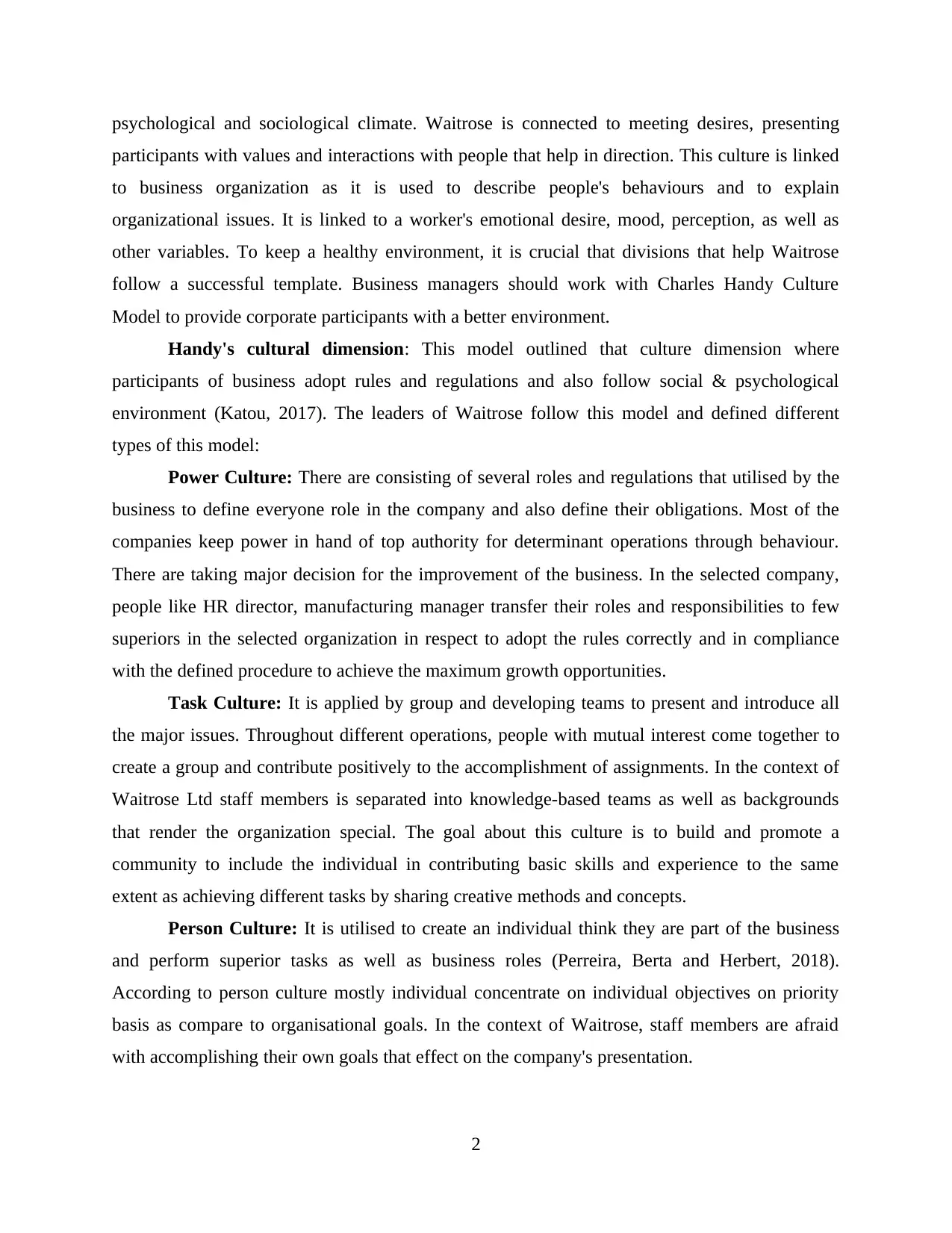
psychological and sociological climate. Waitrose is connected to meeting desires, presenting
participants with values and interactions with people that help in direction. This culture is linked
to business organization as it is used to describe people's behaviours and to explain
organizational issues. It is linked to a worker's emotional desire, mood, perception, as well as
other variables. To keep a healthy environment, it is crucial that divisions that help Waitrose
follow a successful template. Business managers should work with Charles Handy Culture
Model to provide corporate participants with a better environment.
Handy's cultural dimension: This model outlined that culture dimension where
participants of business adopt rules and regulations and also follow social & psychological
environment (Katou, 2017). The leaders of Waitrose follow this model and defined different
types of this model:
Power Culture: There are consisting of several roles and regulations that utilised by the
business to define everyone role in the company and also define their obligations. Most of the
companies keep power in hand of top authority for determinant operations through behaviour.
There are taking major decision for the improvement of the business. In the selected company,
people like HR director, manufacturing manager transfer their roles and responsibilities to few
superiors in the selected organization in respect to adopt the rules correctly and in compliance
with the defined procedure to achieve the maximum growth opportunities.
Task Culture: It is applied by group and developing teams to present and introduce all
the major issues. Throughout different operations, people with mutual interest come together to
create a group and contribute positively to the accomplishment of assignments. In the context of
Waitrose Ltd staff members is separated into knowledge-based teams as well as backgrounds
that render the organization special. The goal about this culture is to build and promote a
community to include the individual in contributing basic skills and experience to the same
extent as achieving different tasks by sharing creative methods and concepts.
Person Culture: It is utilised to create an individual think they are part of the business
and perform superior tasks as well as business roles (Perreira, Berta and Herbert, 2018).
According to person culture mostly individual concentrate on individual objectives on priority
basis as compare to organisational goals. In the context of Waitrose, staff members are afraid
with accomplishing their own goals that effect on the company's presentation.
2
participants with values and interactions with people that help in direction. This culture is linked
to business organization as it is used to describe people's behaviours and to explain
organizational issues. It is linked to a worker's emotional desire, mood, perception, as well as
other variables. To keep a healthy environment, it is crucial that divisions that help Waitrose
follow a successful template. Business managers should work with Charles Handy Culture
Model to provide corporate participants with a better environment.
Handy's cultural dimension: This model outlined that culture dimension where
participants of business adopt rules and regulations and also follow social & psychological
environment (Katou, 2017). The leaders of Waitrose follow this model and defined different
types of this model:
Power Culture: There are consisting of several roles and regulations that utilised by the
business to define everyone role in the company and also define their obligations. Most of the
companies keep power in hand of top authority for determinant operations through behaviour.
There are taking major decision for the improvement of the business. In the selected company,
people like HR director, manufacturing manager transfer their roles and responsibilities to few
superiors in the selected organization in respect to adopt the rules correctly and in compliance
with the defined procedure to achieve the maximum growth opportunities.
Task Culture: It is applied by group and developing teams to present and introduce all
the major issues. Throughout different operations, people with mutual interest come together to
create a group and contribute positively to the accomplishment of assignments. In the context of
Waitrose Ltd staff members is separated into knowledge-based teams as well as backgrounds
that render the organization special. The goal about this culture is to build and promote a
community to include the individual in contributing basic skills and experience to the same
extent as achieving different tasks by sharing creative methods and concepts.
Person Culture: It is utilised to create an individual think they are part of the business
and perform superior tasks as well as business roles (Perreira, Berta and Herbert, 2018).
According to person culture mostly individual concentrate on individual objectives on priority
basis as compare to organisational goals. In the context of Waitrose, staff members are afraid
with accomplishing their own goals that effect on the company's presentation.
2
Secure Best Marks with AI Grader
Need help grading? Try our AI Grader for instant feedback on your assignments.
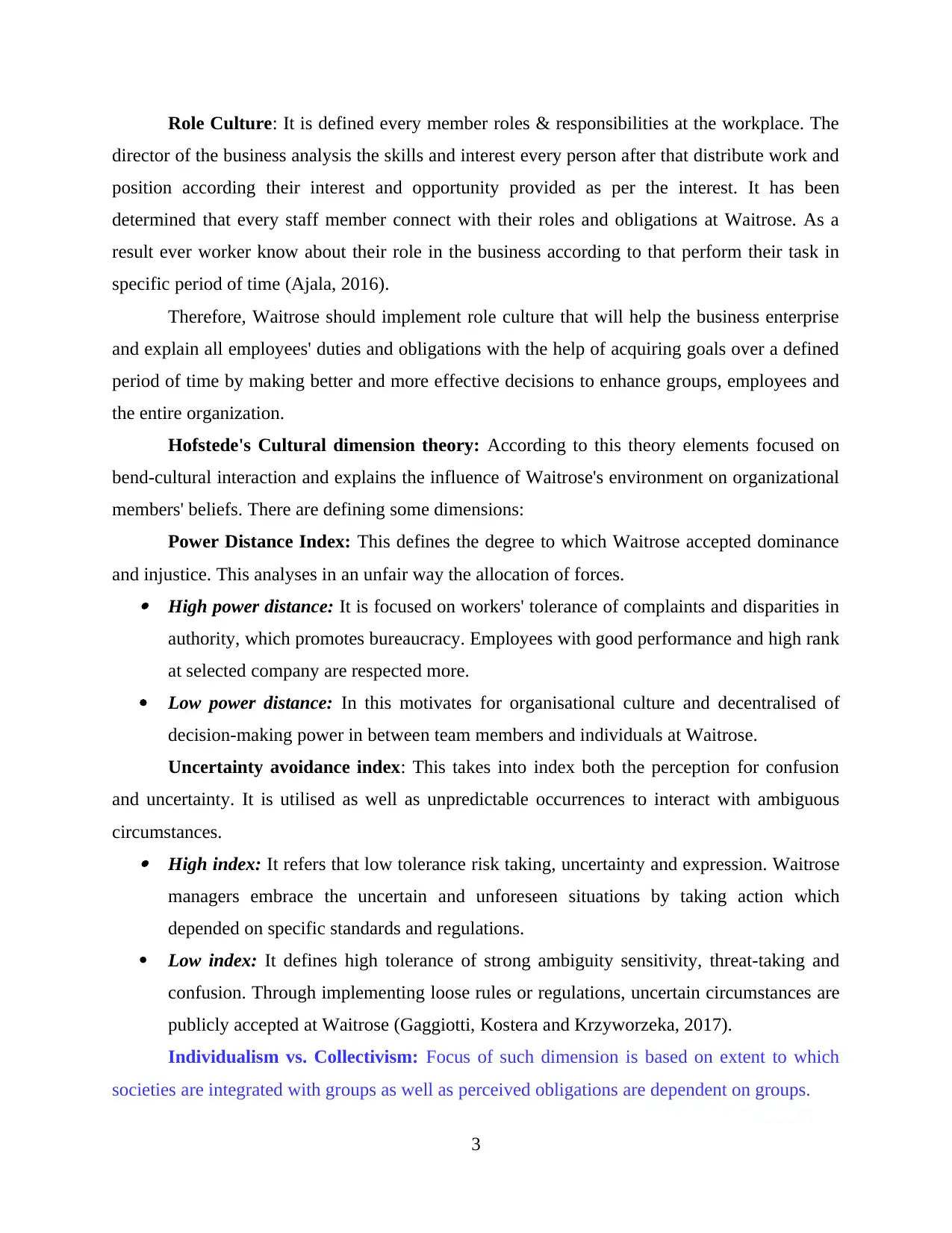
Role Culture: It is defined every member roles & responsibilities at the workplace. The
director of the business analysis the skills and interest every person after that distribute work and
position according their interest and opportunity provided as per the interest. It has been
determined that every staff member connect with their roles and obligations at Waitrose. As a
result ever worker know about their role in the business according to that perform their task in
specific period of time (Ajala, 2016).
Therefore, Waitrose should implement role culture that will help the business enterprise
and explain all employees' duties and obligations with the help of acquiring goals over a defined
period of time by making better and more effective decisions to enhance groups, employees and
the entire organization.
Hofstede's Cultural dimension theory: According to this theory elements focused on
bend-cultural interaction and explains the influence of Waitrose's environment on organizational
members' beliefs. There are defining some dimensions:
Power Distance Index: This defines the degree to which Waitrose accepted dominance
and injustice. This analyses in an unfair way the allocation of forces. High power distance: It is focused on workers' tolerance of complaints and disparities in
authority, which promotes bureaucracy. Employees with good performance and high rank
at selected company are respected more.
Low power distance: In this motivates for organisational culture and decentralised of
decision-making power in between team members and individuals at Waitrose.
Uncertainty avoidance index: This takes into index both the perception for confusion
and uncertainty. It is utilised as well as unpredictable occurrences to interact with ambiguous
circumstances. High index: It refers that low tolerance risk taking, uncertainty and expression. Waitrose
managers embrace the uncertain and unforeseen situations by taking action which
depended on specific standards and regulations.
Low index: It defines high tolerance of strong ambiguity sensitivity, threat-taking and
confusion. Through implementing loose rules or regulations, uncertain circumstances are
publicly accepted at Waitrose (Gaggiotti, Kostera and Krzyworzeka, 2017).
Individualism vs. Collectivism: Focus of such dimension is based on extent to which
societies are integrated with groups as well as perceived obligations are dependent on groups.
3
director of the business analysis the skills and interest every person after that distribute work and
position according their interest and opportunity provided as per the interest. It has been
determined that every staff member connect with their roles and obligations at Waitrose. As a
result ever worker know about their role in the business according to that perform their task in
specific period of time (Ajala, 2016).
Therefore, Waitrose should implement role culture that will help the business enterprise
and explain all employees' duties and obligations with the help of acquiring goals over a defined
period of time by making better and more effective decisions to enhance groups, employees and
the entire organization.
Hofstede's Cultural dimension theory: According to this theory elements focused on
bend-cultural interaction and explains the influence of Waitrose's environment on organizational
members' beliefs. There are defining some dimensions:
Power Distance Index: This defines the degree to which Waitrose accepted dominance
and injustice. This analyses in an unfair way the allocation of forces. High power distance: It is focused on workers' tolerance of complaints and disparities in
authority, which promotes bureaucracy. Employees with good performance and high rank
at selected company are respected more.
Low power distance: In this motivates for organisational culture and decentralised of
decision-making power in between team members and individuals at Waitrose.
Uncertainty avoidance index: This takes into index both the perception for confusion
and uncertainty. It is utilised as well as unpredictable occurrences to interact with ambiguous
circumstances. High index: It refers that low tolerance risk taking, uncertainty and expression. Waitrose
managers embrace the uncertain and unforeseen situations by taking action which
depended on specific standards and regulations.
Low index: It defines high tolerance of strong ambiguity sensitivity, threat-taking and
confusion. Through implementing loose rules or regulations, uncertain circumstances are
publicly accepted at Waitrose (Gaggiotti, Kostera and Krzyworzeka, 2017).
Individualism vs. Collectivism: Focus of such dimension is based on extent to which
societies are integrated with groups as well as perceived obligations are dependent on groups.
3
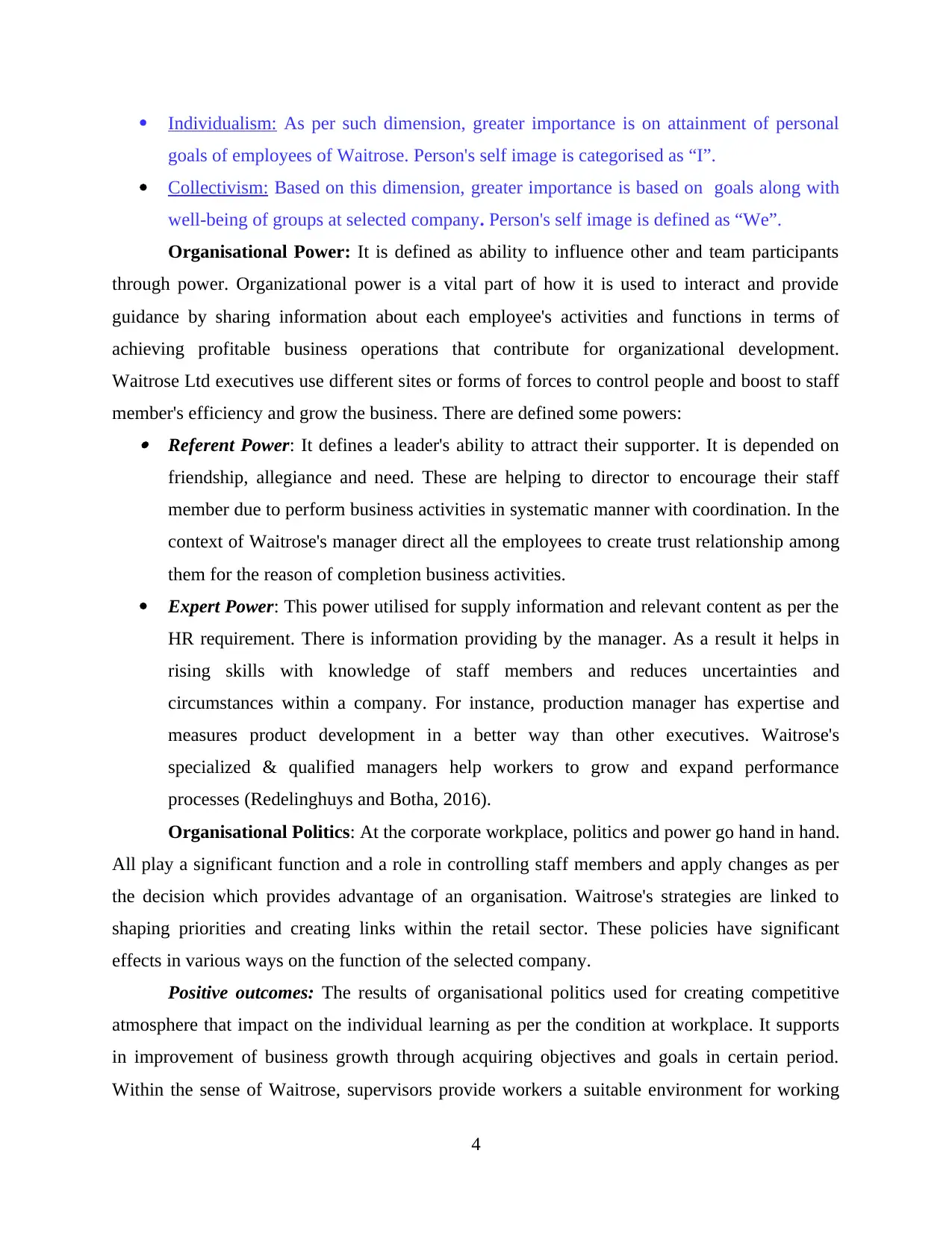
Individualism: As per such dimension, greater importance is on attainment of personal
goals of employees of Waitrose. Person's self image is categorised as “I”.
Collectivism: Based on this dimension, greater importance is based on goals along with
well-being of groups at selected company. Person's self image is defined as “We”.
Organisational Power: It is defined as ability to influence other and team participants
through power. Organizational power is a vital part of how it is used to interact and provide
guidance by sharing information about each employee's activities and functions in terms of
achieving profitable business operations that contribute for organizational development.
Waitrose Ltd executives use different sites or forms of forces to control people and boost to staff
member's efficiency and grow the business. There are defined some powers: Referent Power: It defines a leader's ability to attract their supporter. It is depended on
friendship, allegiance and need. These are helping to director to encourage their staff
member due to perform business activities in systematic manner with coordination. In the
context of Waitrose's manager direct all the employees to create trust relationship among
them for the reason of completion business activities.
Expert Power: This power utilised for supply information and relevant content as per the
HR requirement. There is information providing by the manager. As a result it helps in
rising skills with knowledge of staff members and reduces uncertainties and
circumstances within a company. For instance, production manager has expertise and
measures product development in a better way than other executives. Waitrose's
specialized & qualified managers help workers to grow and expand performance
processes (Redelinghuys and Botha, 2016).
Organisational Politics: At the corporate workplace, politics and power go hand in hand.
All play a significant function and a role in controlling staff members and apply changes as per
the decision which provides advantage of an organisation. Waitrose's strategies are linked to
shaping priorities and creating links within the retail sector. These policies have significant
effects in various ways on the function of the selected company.
Positive outcomes: The results of organisational politics used for creating competitive
atmosphere that impact on the individual learning as per the condition at workplace. It supports
in improvement of business growth through acquiring objectives and goals in certain period.
Within the sense of Waitrose, supervisors provide workers a suitable environment for working
4
goals of employees of Waitrose. Person's self image is categorised as “I”.
Collectivism: Based on this dimension, greater importance is based on goals along with
well-being of groups at selected company. Person's self image is defined as “We”.
Organisational Power: It is defined as ability to influence other and team participants
through power. Organizational power is a vital part of how it is used to interact and provide
guidance by sharing information about each employee's activities and functions in terms of
achieving profitable business operations that contribute for organizational development.
Waitrose Ltd executives use different sites or forms of forces to control people and boost to staff
member's efficiency and grow the business. There are defined some powers: Referent Power: It defines a leader's ability to attract their supporter. It is depended on
friendship, allegiance and need. These are helping to director to encourage their staff
member due to perform business activities in systematic manner with coordination. In the
context of Waitrose's manager direct all the employees to create trust relationship among
them for the reason of completion business activities.
Expert Power: This power utilised for supply information and relevant content as per the
HR requirement. There is information providing by the manager. As a result it helps in
rising skills with knowledge of staff members and reduces uncertainties and
circumstances within a company. For instance, production manager has expertise and
measures product development in a better way than other executives. Waitrose's
specialized & qualified managers help workers to grow and expand performance
processes (Redelinghuys and Botha, 2016).
Organisational Politics: At the corporate workplace, politics and power go hand in hand.
All play a significant function and a role in controlling staff members and apply changes as per
the decision which provides advantage of an organisation. Waitrose's strategies are linked to
shaping priorities and creating links within the retail sector. These policies have significant
effects in various ways on the function of the selected company.
Positive outcomes: The results of organisational politics used for creating competitive
atmosphere that impact on the individual learning as per the condition at workplace. It supports
in improvement of business growth through acquiring objectives and goals in certain period.
Within the sense of Waitrose, supervisors provide workers a suitable environment for working
4
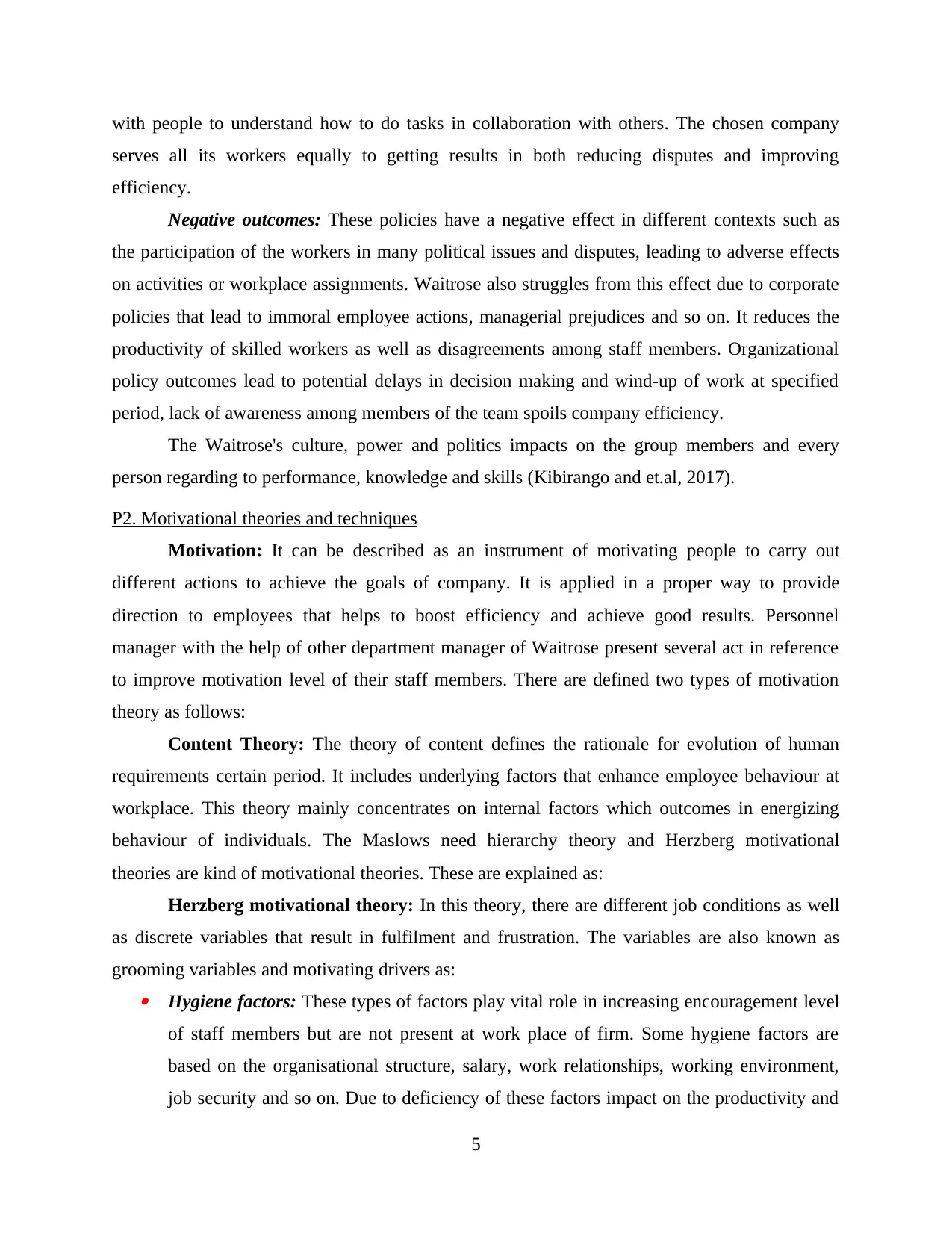
with people to understand how to do tasks in collaboration with others. The chosen company
serves all its workers equally to getting results in both reducing disputes and improving
efficiency.
Negative outcomes: These policies have a negative effect in different contexts such as
the participation of the workers in many political issues and disputes, leading to adverse effects
on activities or workplace assignments. Waitrose also struggles from this effect due to corporate
policies that lead to immoral employee actions, managerial prejudices and so on. It reduces the
productivity of skilled workers as well as disagreements among staff members. Organizational
policy outcomes lead to potential delays in decision making and wind-up of work at specified
period, lack of awareness among members of the team spoils company efficiency.
The Waitrose's culture, power and politics impacts on the group members and every
person regarding to performance, knowledge and skills (Kibirango and et.al, 2017).
P2. Motivational theories and techniques
Motivation: It can be described as an instrument of motivating people to carry out
different actions to achieve the goals of company. It is applied in a proper way to provide
direction to employees that helps to boost efficiency and achieve good results. Personnel
manager with the help of other department manager of Waitrose present several act in reference
to improve motivation level of their staff members. There are defined two types of motivation
theory as follows:
Content Theory: The theory of content defines the rationale for evolution of human
requirements certain period. It includes underlying factors that enhance employee behaviour at
workplace. This theory mainly concentrates on internal factors which outcomes in energizing
behaviour of individuals. The Maslows need hierarchy theory and Herzberg motivational
theories are kind of motivational theories. These are explained as:
Herzberg motivational theory: In this theory, there are different job conditions as well
as discrete variables that result in fulfilment and frustration. The variables are also known as
grooming variables and motivating drivers as: Hygiene factors: These types of factors play vital role in increasing encouragement level
of staff members but are not present at work place of firm. Some hygiene factors are
based on the organisational structure, salary, work relationships, working environment,
job security and so on. Due to deficiency of these factors impact on the productivity and
5
serves all its workers equally to getting results in both reducing disputes and improving
efficiency.
Negative outcomes: These policies have a negative effect in different contexts such as
the participation of the workers in many political issues and disputes, leading to adverse effects
on activities or workplace assignments. Waitrose also struggles from this effect due to corporate
policies that lead to immoral employee actions, managerial prejudices and so on. It reduces the
productivity of skilled workers as well as disagreements among staff members. Organizational
policy outcomes lead to potential delays in decision making and wind-up of work at specified
period, lack of awareness among members of the team spoils company efficiency.
The Waitrose's culture, power and politics impacts on the group members and every
person regarding to performance, knowledge and skills (Kibirango and et.al, 2017).
P2. Motivational theories and techniques
Motivation: It can be described as an instrument of motivating people to carry out
different actions to achieve the goals of company. It is applied in a proper way to provide
direction to employees that helps to boost efficiency and achieve good results. Personnel
manager with the help of other department manager of Waitrose present several act in reference
to improve motivation level of their staff members. There are defined two types of motivation
theory as follows:
Content Theory: The theory of content defines the rationale for evolution of human
requirements certain period. It includes underlying factors that enhance employee behaviour at
workplace. This theory mainly concentrates on internal factors which outcomes in energizing
behaviour of individuals. The Maslows need hierarchy theory and Herzberg motivational
theories are kind of motivational theories. These are explained as:
Herzberg motivational theory: In this theory, there are different job conditions as well
as discrete variables that result in fulfilment and frustration. The variables are also known as
grooming variables and motivating drivers as: Hygiene factors: These types of factors play vital role in increasing encouragement level
of staff members but are not present at work place of firm. Some hygiene factors are
based on the organisational structure, salary, work relationships, working environment,
job security and so on. Due to deficiency of these factors impact on the productivity and
5
Paraphrase This Document
Need a fresh take? Get an instant paraphrase of this document with our AI Paraphraser
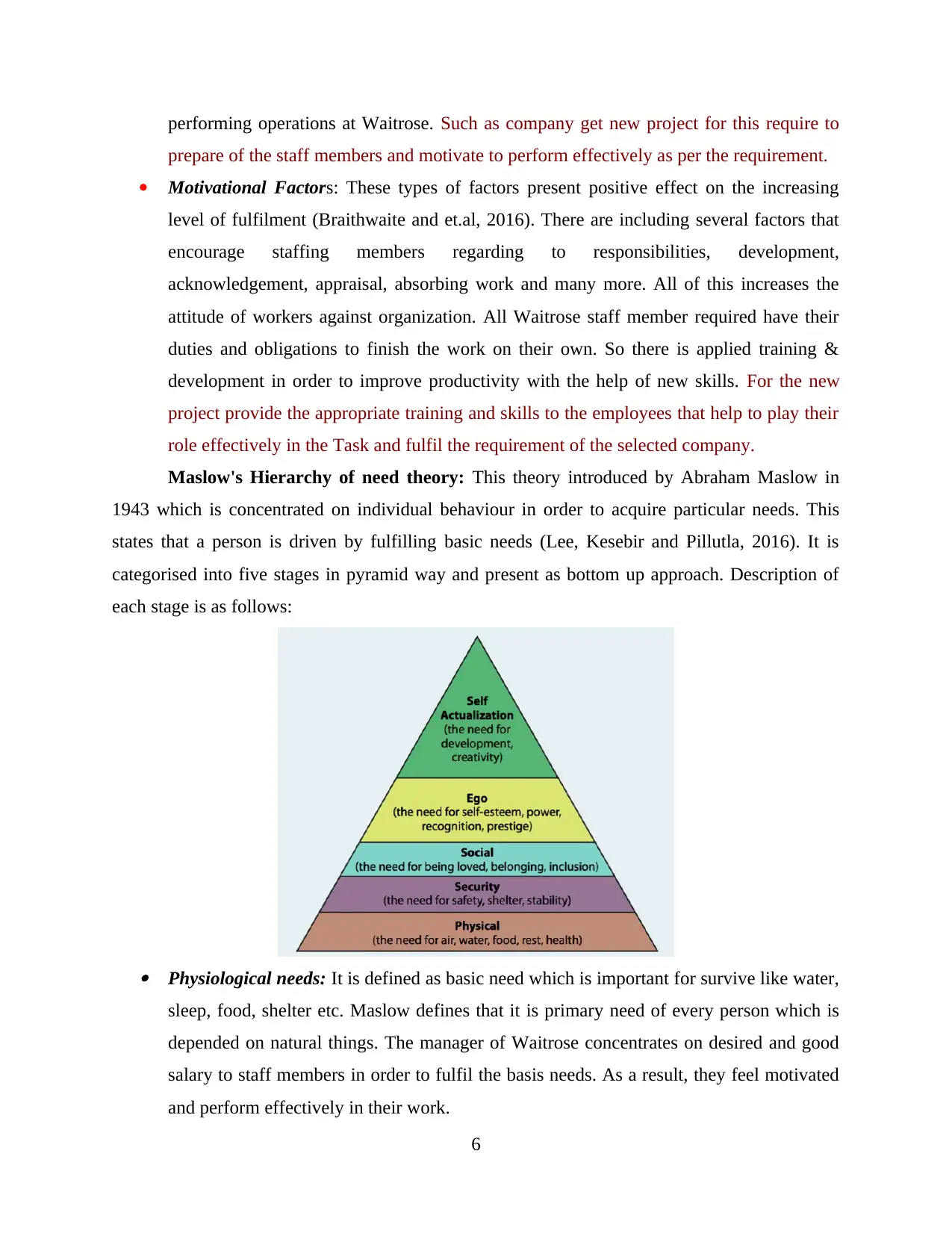
performing operations at Waitrose. Such as company get new project for this require to
prepare of the staff members and motivate to perform effectively as per the requirement.
Motivational Factors: These types of factors present positive effect on the increasing
level of fulfilment (Braithwaite and et.al, 2016). There are including several factors that
encourage staffing members regarding to responsibilities, development,
acknowledgement, appraisal, absorbing work and many more. All of this increases the
attitude of workers against organization. All Waitrose staff member required have their
duties and obligations to finish the work on their own. So there is applied training &
development in order to improve productivity with the help of new skills. For the new
project provide the appropriate training and skills to the employees that help to play their
role effectively in the Task and fulfil the requirement of the selected company.
Maslow's Hierarchy of need theory: This theory introduced by Abraham Maslow in
1943 which is concentrated on individual behaviour in order to acquire particular needs. This
states that a person is driven by fulfilling basic needs (Lee, Kesebir and Pillutla, 2016). It is
categorised into five stages in pyramid way and present as bottom up approach. Description of
each stage is as follows:
Physiological needs: It is defined as basic need which is important for survive like water,
sleep, food, shelter etc. Maslow defines that it is primary need of every person which is
depended on natural things. The manager of Waitrose concentrates on desired and good
salary to staff members in order to fulfil the basis needs. As a result, they feel motivated
and perform effectively in their work.
6
prepare of the staff members and motivate to perform effectively as per the requirement.
Motivational Factors: These types of factors present positive effect on the increasing
level of fulfilment (Braithwaite and et.al, 2016). There are including several factors that
encourage staffing members regarding to responsibilities, development,
acknowledgement, appraisal, absorbing work and many more. All of this increases the
attitude of workers against organization. All Waitrose staff member required have their
duties and obligations to finish the work on their own. So there is applied training &
development in order to improve productivity with the help of new skills. For the new
project provide the appropriate training and skills to the employees that help to play their
role effectively in the Task and fulfil the requirement of the selected company.
Maslow's Hierarchy of need theory: This theory introduced by Abraham Maslow in
1943 which is concentrated on individual behaviour in order to acquire particular needs. This
states that a person is driven by fulfilling basic needs (Lee, Kesebir and Pillutla, 2016). It is
categorised into five stages in pyramid way and present as bottom up approach. Description of
each stage is as follows:
Physiological needs: It is defined as basic need which is important for survive like water,
sleep, food, shelter etc. Maslow defines that it is primary need of every person which is
depended on natural things. The manager of Waitrose concentrates on desired and good
salary to staff members in order to fulfil the basis needs. As a result, they feel motivated
and perform effectively in their work.
6
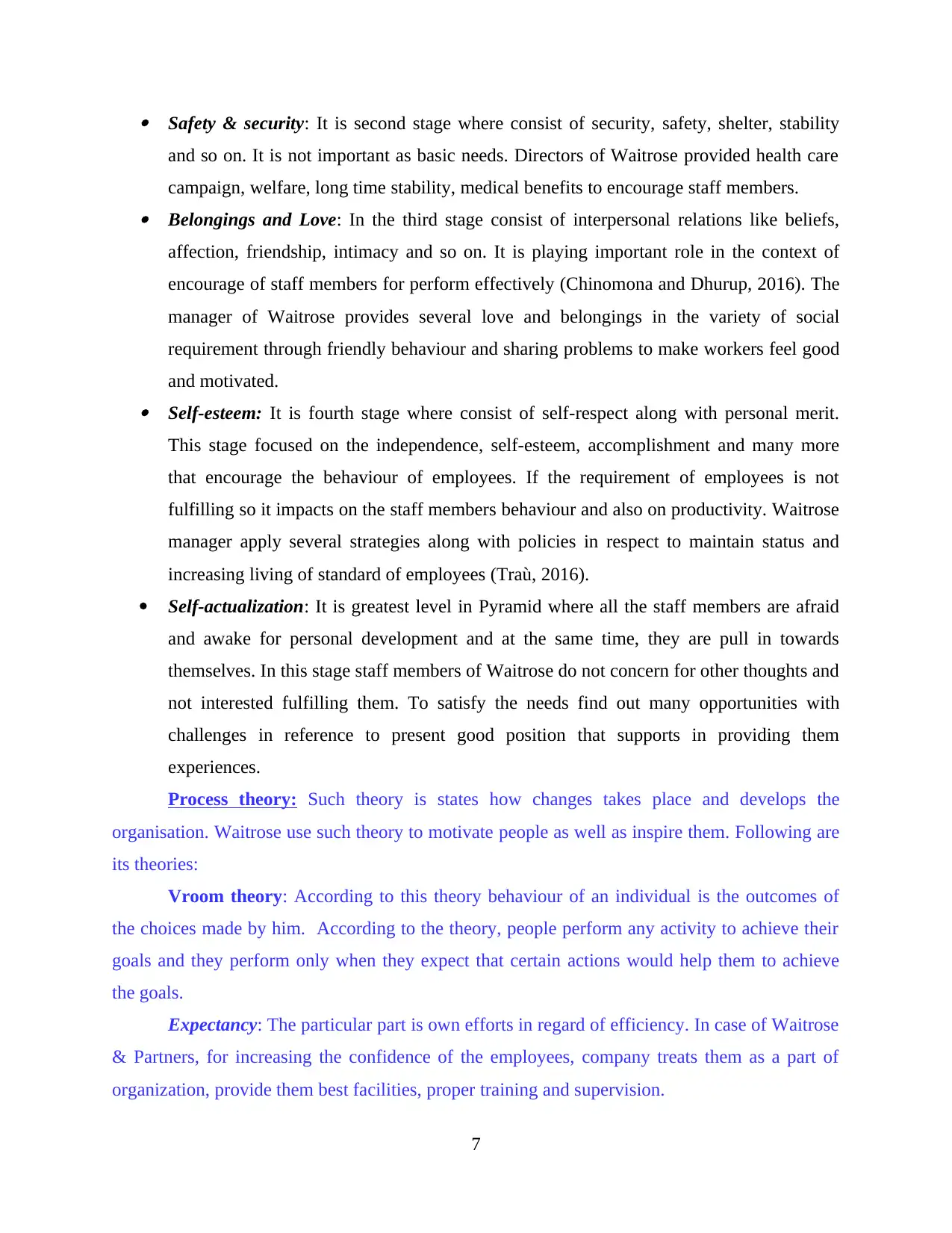
Safety & security: It is second stage where consist of security, safety, shelter, stability
and so on. It is not important as basic needs. Directors of Waitrose provided health care
campaign, welfare, long time stability, medical benefits to encourage staff members. Belongings and Love: In the third stage consist of interpersonal relations like beliefs,
affection, friendship, intimacy and so on. It is playing important role in the context of
encourage of staff members for perform effectively (Chinomona and Dhurup, 2016). The
manager of Waitrose provides several love and belongings in the variety of social
requirement through friendly behaviour and sharing problems to make workers feel good
and motivated. Self-esteem: It is fourth stage where consist of self-respect along with personal merit.
This stage focused on the independence, self-esteem, accomplishment and many more
that encourage the behaviour of employees. If the requirement of employees is not
fulfilling so it impacts on the staff members behaviour and also on productivity. Waitrose
manager apply several strategies along with policies in respect to maintain status and
increasing living of standard of employees (Traù, 2016).
Self-actualization: It is greatest level in Pyramid where all the staff members are afraid
and awake for personal development and at the same time, they are pull in towards
themselves. In this stage staff members of Waitrose do not concern for other thoughts and
not interested fulfilling them. To satisfy the needs find out many opportunities with
challenges in reference to present good position that supports in providing them
experiences.
Process theory: Such theory is states how changes takes place and develops the
organisation. Waitrose use such theory to motivate people as well as inspire them. Following are
its theories:
Vroom theory: According to this theory behaviour of an individual is the outcomes of
the choices made by him. According to the theory, people perform any activity to achieve their
goals and they perform only when they expect that certain actions would help them to achieve
the goals.
Expectancy: The particular part is own efforts in regard of efficiency. In case of Waitrose
& Partners, for increasing the confidence of the employees, company treats them as a part of
organization, provide them best facilities, proper training and supervision.
7
and so on. It is not important as basic needs. Directors of Waitrose provided health care
campaign, welfare, long time stability, medical benefits to encourage staff members. Belongings and Love: In the third stage consist of interpersonal relations like beliefs,
affection, friendship, intimacy and so on. It is playing important role in the context of
encourage of staff members for perform effectively (Chinomona and Dhurup, 2016). The
manager of Waitrose provides several love and belongings in the variety of social
requirement through friendly behaviour and sharing problems to make workers feel good
and motivated. Self-esteem: It is fourth stage where consist of self-respect along with personal merit.
This stage focused on the independence, self-esteem, accomplishment and many more
that encourage the behaviour of employees. If the requirement of employees is not
fulfilling so it impacts on the staff members behaviour and also on productivity. Waitrose
manager apply several strategies along with policies in respect to maintain status and
increasing living of standard of employees (Traù, 2016).
Self-actualization: It is greatest level in Pyramid where all the staff members are afraid
and awake for personal development and at the same time, they are pull in towards
themselves. In this stage staff members of Waitrose do not concern for other thoughts and
not interested fulfilling them. To satisfy the needs find out many opportunities with
challenges in reference to present good position that supports in providing them
experiences.
Process theory: Such theory is states how changes takes place and develops the
organisation. Waitrose use such theory to motivate people as well as inspire them. Following are
its theories:
Vroom theory: According to this theory behaviour of an individual is the outcomes of
the choices made by him. According to the theory, people perform any activity to achieve their
goals and they perform only when they expect that certain actions would help them to achieve
the goals.
Expectancy: The particular part is own efforts in regard of efficiency. In case of Waitrose
& Partners, for increasing the confidence of the employees, company treats them as a part of
organization, provide them best facilities, proper training and supervision.
7
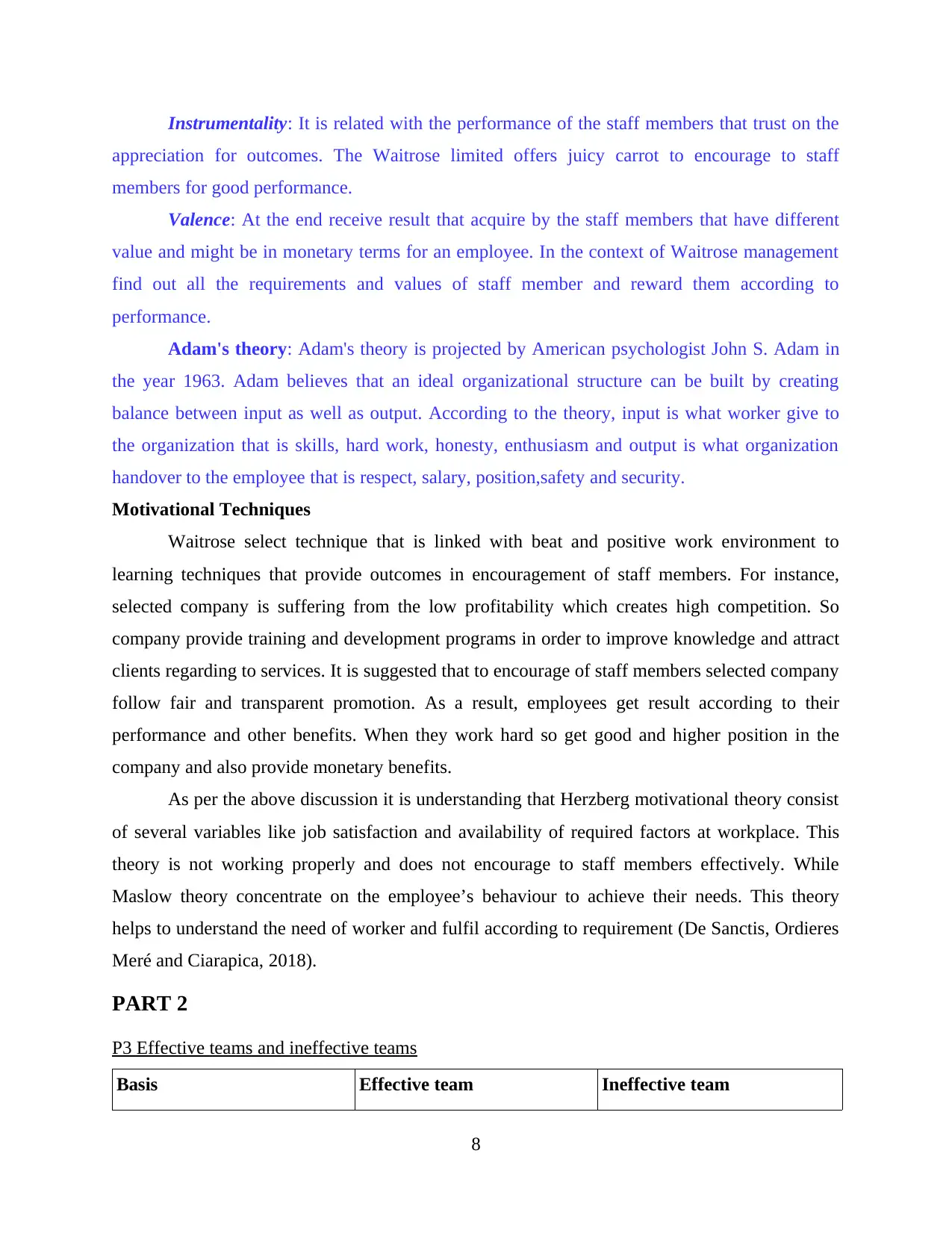
Instrumentality: It is related with the performance of the staff members that trust on the
appreciation for outcomes. The Waitrose limited offers juicy carrot to encourage to staff
members for good performance.
Valence: At the end receive result that acquire by the staff members that have different
value and might be in monetary terms for an employee. In the context of Waitrose management
find out all the requirements and values of staff member and reward them according to
performance.
Adam's theory: Adam's theory is projected by American psychologist John S. Adam in
the year 1963. Adam believes that an ideal organizational structure can be built by creating
balance between input as well as output. According to the theory, input is what worker give to
the organization that is skills, hard work, honesty, enthusiasm and output is what organization
handover to the employee that is respect, salary, position,safety and security.
Motivational Techniques
Waitrose select technique that is linked with beat and positive work environment to
learning techniques that provide outcomes in encouragement of staff members. For instance,
selected company is suffering from the low profitability which creates high competition. So
company provide training and development programs in order to improve knowledge and attract
clients regarding to services. It is suggested that to encourage of staff members selected company
follow fair and transparent promotion. As a result, employees get result according to their
performance and other benefits. When they work hard so get good and higher position in the
company and also provide monetary benefits.
As per the above discussion it is understanding that Herzberg motivational theory consist
of several variables like job satisfaction and availability of required factors at workplace. This
theory is not working properly and does not encourage to staff members effectively. While
Maslow theory concentrate on the employee’s behaviour to achieve their needs. This theory
helps to understand the need of worker and fulfil according to requirement (De Sanctis, Ordieres
Meré and Ciarapica, 2018).
PART 2
P3 Effective teams and ineffective teams
Basis Effective team Ineffective team
8
appreciation for outcomes. The Waitrose limited offers juicy carrot to encourage to staff
members for good performance.
Valence: At the end receive result that acquire by the staff members that have different
value and might be in monetary terms for an employee. In the context of Waitrose management
find out all the requirements and values of staff member and reward them according to
performance.
Adam's theory: Adam's theory is projected by American psychologist John S. Adam in
the year 1963. Adam believes that an ideal organizational structure can be built by creating
balance between input as well as output. According to the theory, input is what worker give to
the organization that is skills, hard work, honesty, enthusiasm and output is what organization
handover to the employee that is respect, salary, position,safety and security.
Motivational Techniques
Waitrose select technique that is linked with beat and positive work environment to
learning techniques that provide outcomes in encouragement of staff members. For instance,
selected company is suffering from the low profitability which creates high competition. So
company provide training and development programs in order to improve knowledge and attract
clients regarding to services. It is suggested that to encourage of staff members selected company
follow fair and transparent promotion. As a result, employees get result according to their
performance and other benefits. When they work hard so get good and higher position in the
company and also provide monetary benefits.
As per the above discussion it is understanding that Herzberg motivational theory consist
of several variables like job satisfaction and availability of required factors at workplace. This
theory is not working properly and does not encourage to staff members effectively. While
Maslow theory concentrate on the employee’s behaviour to achieve their needs. This theory
helps to understand the need of worker and fulfil according to requirement (De Sanctis, Ordieres
Meré and Ciarapica, 2018).
PART 2
P3 Effective teams and ineffective teams
Basis Effective team Ineffective team
8
Secure Best Marks with AI Grader
Need help grading? Try our AI Grader for instant feedback on your assignments.
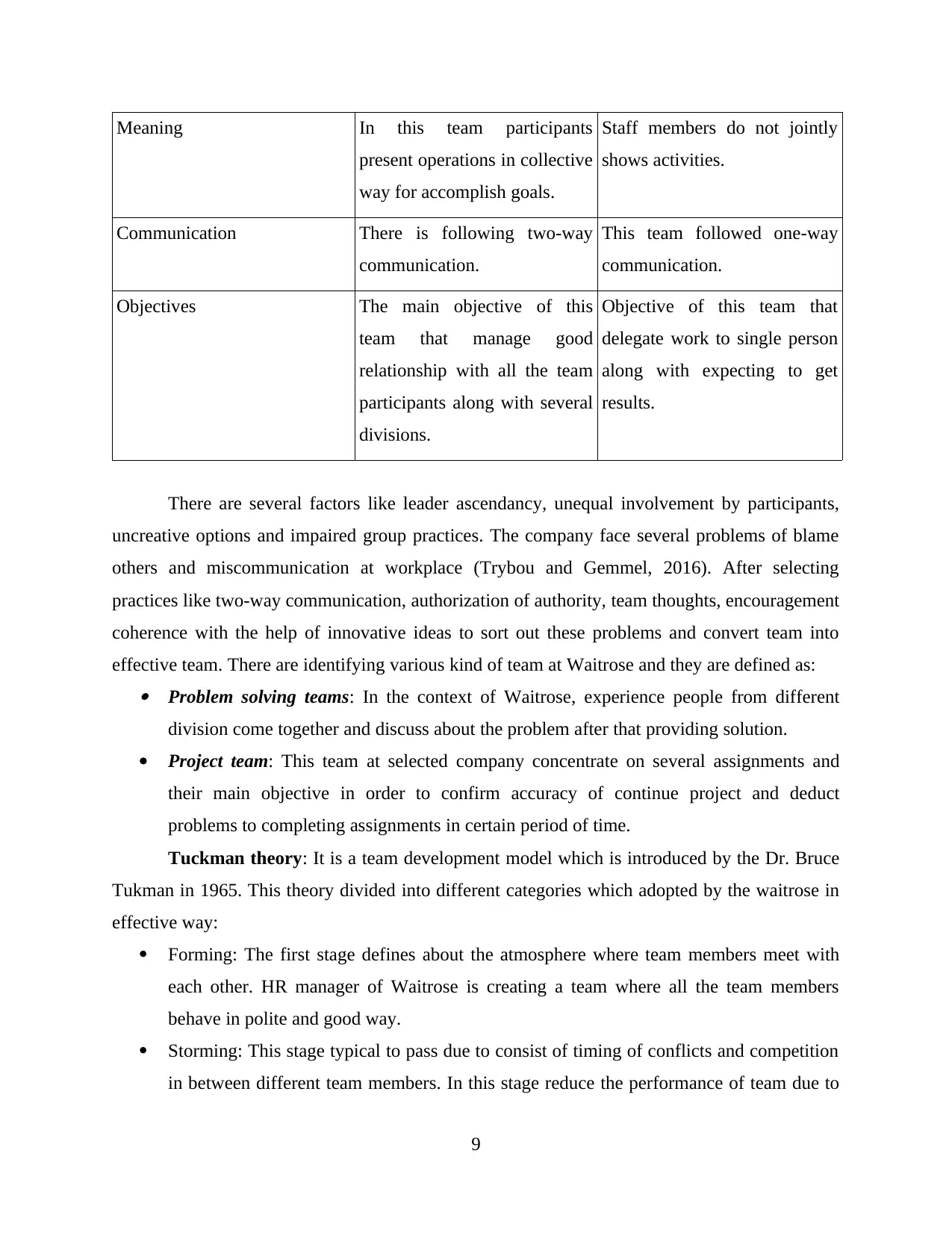
Meaning In this team participants
present operations in collective
way for accomplish goals.
Staff members do not jointly
shows activities.
Communication There is following two-way
communication.
This team followed one-way
communication.
Objectives The main objective of this
team that manage good
relationship with all the team
participants along with several
divisions.
Objective of this team that
delegate work to single person
along with expecting to get
results.
There are several factors like leader ascendancy, unequal involvement by participants,
uncreative options and impaired group practices. The company face several problems of blame
others and miscommunication at workplace (Trybou and Gemmel, 2016). After selecting
practices like two-way communication, authorization of authority, team thoughts, encouragement
coherence with the help of innovative ideas to sort out these problems and convert team into
effective team. There are identifying various kind of team at Waitrose and they are defined as: Problem solving teams: In the context of Waitrose, experience people from different
division come together and discuss about the problem after that providing solution.
Project team: This team at selected company concentrate on several assignments and
their main objective in order to confirm accuracy of continue project and deduct
problems to completing assignments in certain period of time.
Tuckman theory: It is a team development model which is introduced by the Dr. Bruce
Tukman in 1965. This theory divided into different categories which adopted by the waitrose in
effective way:
Forming: The first stage defines about the atmosphere where team members meet with
each other. HR manager of Waitrose is creating a team where all the team members
behave in polite and good way.
Storming: This stage typical to pass due to consist of timing of conflicts and competition
in between different team members. In this stage reduce the performance of team due to
9
present operations in collective
way for accomplish goals.
Staff members do not jointly
shows activities.
Communication There is following two-way
communication.
This team followed one-way
communication.
Objectives The main objective of this
team that manage good
relationship with all the team
participants along with several
divisions.
Objective of this team that
delegate work to single person
along with expecting to get
results.
There are several factors like leader ascendancy, unequal involvement by participants,
uncreative options and impaired group practices. The company face several problems of blame
others and miscommunication at workplace (Trybou and Gemmel, 2016). After selecting
practices like two-way communication, authorization of authority, team thoughts, encouragement
coherence with the help of innovative ideas to sort out these problems and convert team into
effective team. There are identifying various kind of team at Waitrose and they are defined as: Problem solving teams: In the context of Waitrose, experience people from different
division come together and discuss about the problem after that providing solution.
Project team: This team at selected company concentrate on several assignments and
their main objective in order to confirm accuracy of continue project and deduct
problems to completing assignments in certain period of time.
Tuckman theory: It is a team development model which is introduced by the Dr. Bruce
Tukman in 1965. This theory divided into different categories which adopted by the waitrose in
effective way:
Forming: The first stage defines about the atmosphere where team members meet with
each other. HR manager of Waitrose is creating a team where all the team members
behave in polite and good way.
Storming: This stage typical to pass due to consist of timing of conflicts and competition
in between different team members. In this stage reduce the performance of team due to
9
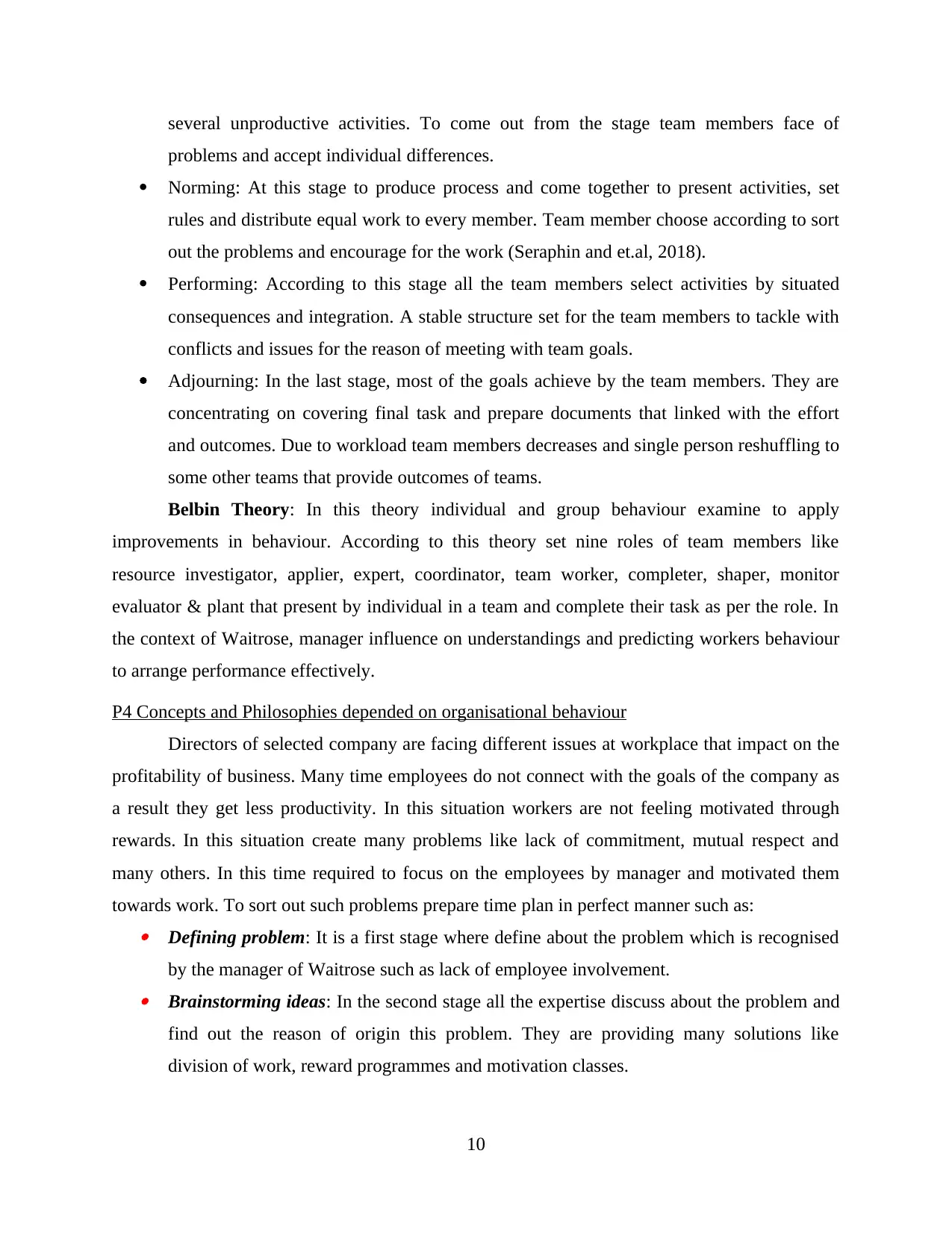
several unproductive activities. To come out from the stage team members face of
problems and accept individual differences.
Norming: At this stage to produce process and come together to present activities, set
rules and distribute equal work to every member. Team member choose according to sort
out the problems and encourage for the work (Seraphin and et.al, 2018).
Performing: According to this stage all the team members select activities by situated
consequences and integration. A stable structure set for the team members to tackle with
conflicts and issues for the reason of meeting with team goals.
Adjourning: In the last stage, most of the goals achieve by the team members. They are
concentrating on covering final task and prepare documents that linked with the effort
and outcomes. Due to workload team members decreases and single person reshuffling to
some other teams that provide outcomes of teams.
Belbin Theory: In this theory individual and group behaviour examine to apply
improvements in behaviour. According to this theory set nine roles of team members like
resource investigator, applier, expert, coordinator, team worker, completer, shaper, monitor
evaluator & plant that present by individual in a team and complete their task as per the role. In
the context of Waitrose, manager influence on understandings and predicting workers behaviour
to arrange performance effectively.
P4 Concepts and Philosophies depended on organisational behaviour
Directors of selected company are facing different issues at workplace that impact on the
profitability of business. Many time employees do not connect with the goals of the company as
a result they get less productivity. In this situation workers are not feeling motivated through
rewards. In this situation create many problems like lack of commitment, mutual respect and
many others. In this time required to focus on the employees by manager and motivated them
towards work. To sort out such problems prepare time plan in perfect manner such as: Defining problem: It is a first stage where define about the problem which is recognised
by the manager of Waitrose such as lack of employee involvement. Brainstorming ideas: In the second stage all the expertise discuss about the problem and
find out the reason of origin this problem. They are providing many solutions like
division of work, reward programmes and motivation classes.
10
problems and accept individual differences.
Norming: At this stage to produce process and come together to present activities, set
rules and distribute equal work to every member. Team member choose according to sort
out the problems and encourage for the work (Seraphin and et.al, 2018).
Performing: According to this stage all the team members select activities by situated
consequences and integration. A stable structure set for the team members to tackle with
conflicts and issues for the reason of meeting with team goals.
Adjourning: In the last stage, most of the goals achieve by the team members. They are
concentrating on covering final task and prepare documents that linked with the effort
and outcomes. Due to workload team members decreases and single person reshuffling to
some other teams that provide outcomes of teams.
Belbin Theory: In this theory individual and group behaviour examine to apply
improvements in behaviour. According to this theory set nine roles of team members like
resource investigator, applier, expert, coordinator, team worker, completer, shaper, monitor
evaluator & plant that present by individual in a team and complete their task as per the role. In
the context of Waitrose, manager influence on understandings and predicting workers behaviour
to arrange performance effectively.
P4 Concepts and Philosophies depended on organisational behaviour
Directors of selected company are facing different issues at workplace that impact on the
profitability of business. Many time employees do not connect with the goals of the company as
a result they get less productivity. In this situation workers are not feeling motivated through
rewards. In this situation create many problems like lack of commitment, mutual respect and
many others. In this time required to focus on the employees by manager and motivated them
towards work. To sort out such problems prepare time plan in perfect manner such as: Defining problem: It is a first stage where define about the problem which is recognised
by the manager of Waitrose such as lack of employee involvement. Brainstorming ideas: In the second stage all the expertise discuss about the problem and
find out the reason of origin this problem. They are providing many solutions like
division of work, reward programmes and motivation classes.
10
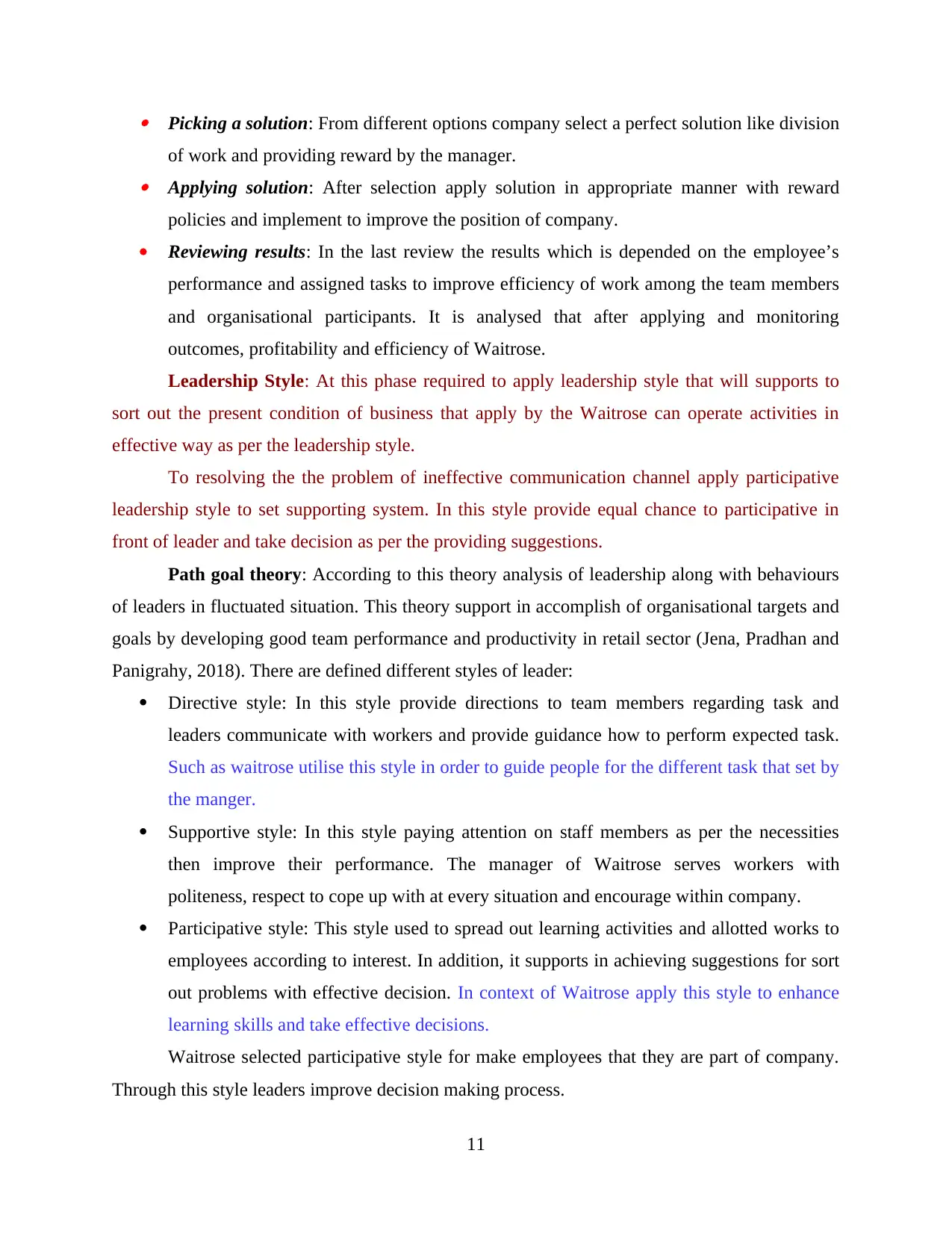
Picking a solution: From different options company select a perfect solution like division
of work and providing reward by the manager. Applying solution: After selection apply solution in appropriate manner with reward
policies and implement to improve the position of company.
Reviewing results: In the last review the results which is depended on the employee’s
performance and assigned tasks to improve efficiency of work among the team members
and organisational participants. It is analysed that after applying and monitoring
outcomes, profitability and efficiency of Waitrose.
Leadership Style: At this phase required to apply leadership style that will supports to
sort out the present condition of business that apply by the Waitrose can operate activities in
effective way as per the leadership style.
To resolving the the problem of ineffective communication channel apply participative
leadership style to set supporting system. In this style provide equal chance to participative in
front of leader and take decision as per the providing suggestions.
Path goal theory: According to this theory analysis of leadership along with behaviours
of leaders in fluctuated situation. This theory support in accomplish of organisational targets and
goals by developing good team performance and productivity in retail sector (Jena, Pradhan and
Panigrahy, 2018). There are defined different styles of leader:
Directive style: In this style provide directions to team members regarding task and
leaders communicate with workers and provide guidance how to perform expected task.
Such as waitrose utilise this style in order to guide people for the different task that set by
the manger.
Supportive style: In this style paying attention on staff members as per the necessities
then improve their performance. The manager of Waitrose serves workers with
politeness, respect to cope up with at every situation and encourage within company.
Participative style: This style used to spread out learning activities and allotted works to
employees according to interest. In addition, it supports in achieving suggestions for sort
out problems with effective decision. In context of Waitrose apply this style to enhance
learning skills and take effective decisions.
Waitrose selected participative style for make employees that they are part of company.
Through this style leaders improve decision making process.
11
of work and providing reward by the manager. Applying solution: After selection apply solution in appropriate manner with reward
policies and implement to improve the position of company.
Reviewing results: In the last review the results which is depended on the employee’s
performance and assigned tasks to improve efficiency of work among the team members
and organisational participants. It is analysed that after applying and monitoring
outcomes, profitability and efficiency of Waitrose.
Leadership Style: At this phase required to apply leadership style that will supports to
sort out the present condition of business that apply by the Waitrose can operate activities in
effective way as per the leadership style.
To resolving the the problem of ineffective communication channel apply participative
leadership style to set supporting system. In this style provide equal chance to participative in
front of leader and take decision as per the providing suggestions.
Path goal theory: According to this theory analysis of leadership along with behaviours
of leaders in fluctuated situation. This theory support in accomplish of organisational targets and
goals by developing good team performance and productivity in retail sector (Jena, Pradhan and
Panigrahy, 2018). There are defined different styles of leader:
Directive style: In this style provide directions to team members regarding task and
leaders communicate with workers and provide guidance how to perform expected task.
Such as waitrose utilise this style in order to guide people for the different task that set by
the manger.
Supportive style: In this style paying attention on staff members as per the necessities
then improve their performance. The manager of Waitrose serves workers with
politeness, respect to cope up with at every situation and encourage within company.
Participative style: This style used to spread out learning activities and allotted works to
employees according to interest. In addition, it supports in achieving suggestions for sort
out problems with effective decision. In context of Waitrose apply this style to enhance
learning skills and take effective decisions.
Waitrose selected participative style for make employees that they are part of company.
Through this style leaders improve decision making process.
11
Paraphrase This Document
Need a fresh take? Get an instant paraphrase of this document with our AI Paraphraser
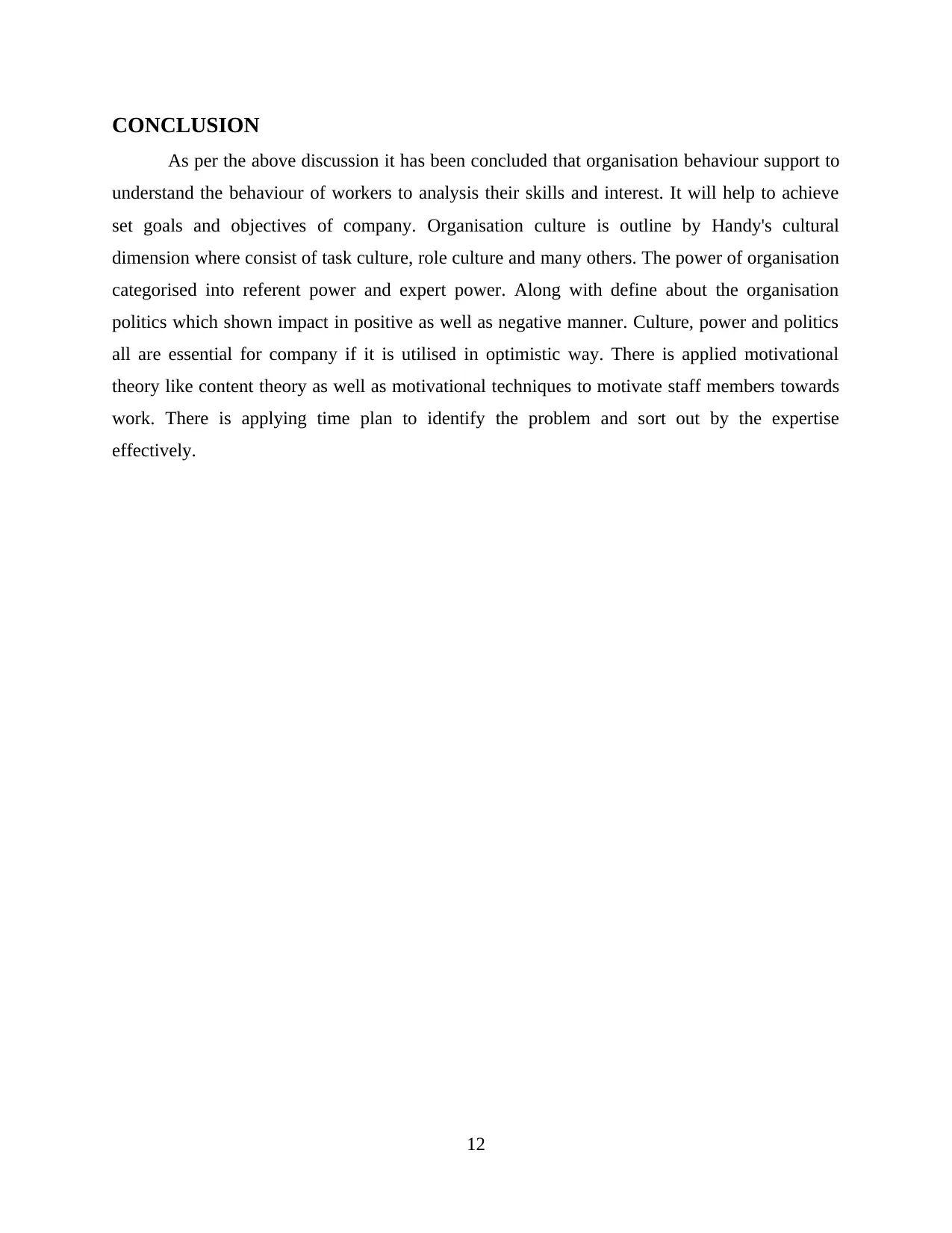
CONCLUSION
As per the above discussion it has been concluded that organisation behaviour support to
understand the behaviour of workers to analysis their skills and interest. It will help to achieve
set goals and objectives of company. Organisation culture is outline by Handy's cultural
dimension where consist of task culture, role culture and many others. The power of organisation
categorised into referent power and expert power. Along with define about the organisation
politics which shown impact in positive as well as negative manner. Culture, power and politics
all are essential for company if it is utilised in optimistic way. There is applied motivational
theory like content theory as well as motivational techniques to motivate staff members towards
work. There is applying time plan to identify the problem and sort out by the expertise
effectively.
12
As per the above discussion it has been concluded that organisation behaviour support to
understand the behaviour of workers to analysis their skills and interest. It will help to achieve
set goals and objectives of company. Organisation culture is outline by Handy's cultural
dimension where consist of task culture, role culture and many others. The power of organisation
categorised into referent power and expert power. Along with define about the organisation
politics which shown impact in positive as well as negative manner. Culture, power and politics
all are essential for company if it is utilised in optimistic way. There is applied motivational
theory like content theory as well as motivational techniques to motivate staff members towards
work. There is applying time plan to identify the problem and sort out by the expertise
effectively.
12
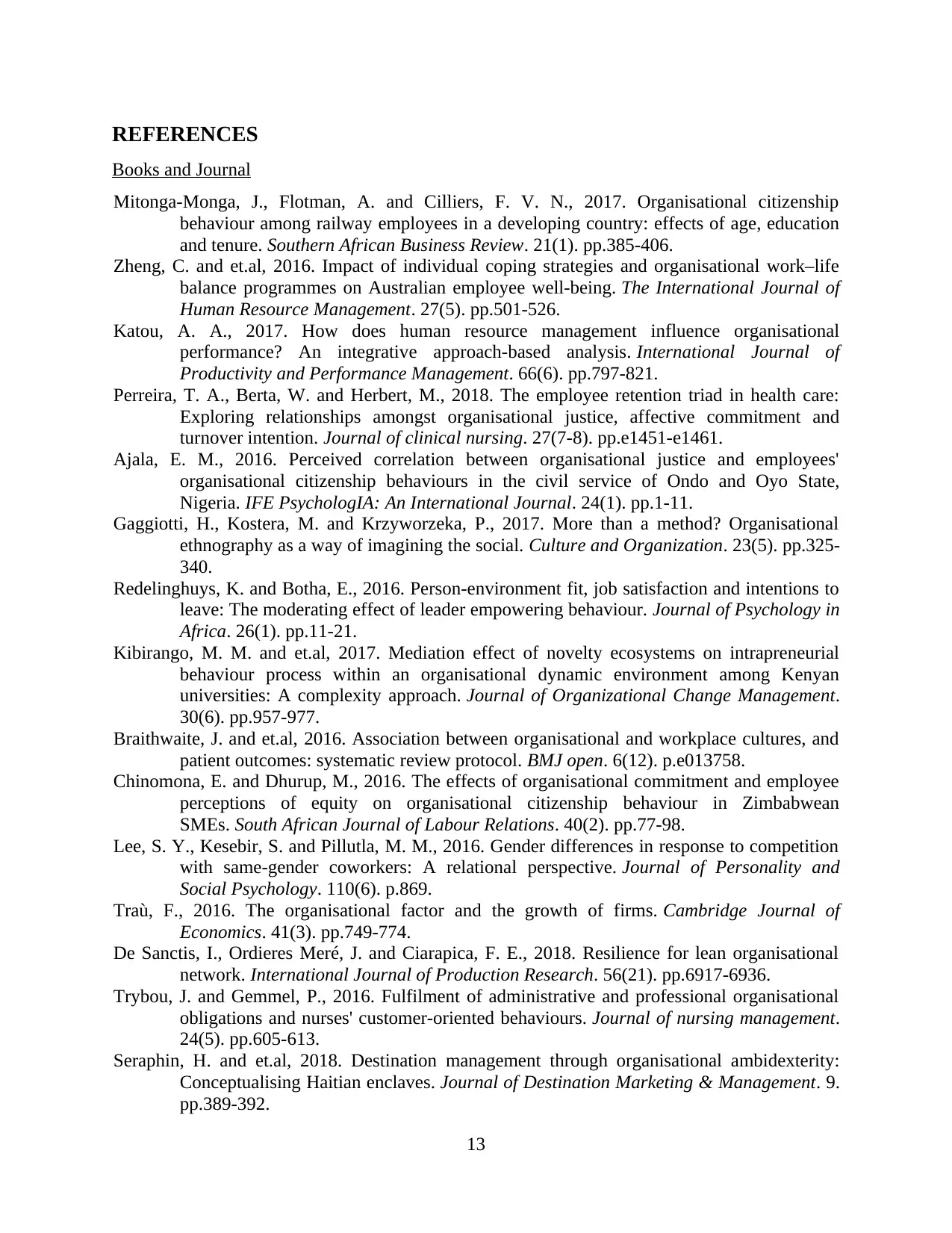
REFERENCES
Books and Journal
Mitonga-Monga, J., Flotman, A. and Cilliers, F. V. N., 2017. Organisational citizenship
behaviour among railway employees in a developing country: effects of age, education
and tenure. Southern African Business Review. 21(1). pp.385-406.
Zheng, C. and et.al, 2016. Impact of individual coping strategies and organisational work–life
balance programmes on Australian employee well-being. The International Journal of
Human Resource Management. 27(5). pp.501-526.
Katou, A. A., 2017. How does human resource management influence organisational
performance? An integrative approach-based analysis. International Journal of
Productivity and Performance Management. 66(6). pp.797-821.
Perreira, T. A., Berta, W. and Herbert, M., 2018. The employee retention triad in health care:
Exploring relationships amongst organisational justice, affective commitment and
turnover intention. Journal of clinical nursing. 27(7-8). pp.e1451-e1461.
Ajala, E. M., 2016. Perceived correlation between organisational justice and employees'
organisational citizenship behaviours in the civil service of Ondo and Oyo State,
Nigeria. IFE PsychologIA: An International Journal. 24(1). pp.1-11.
Gaggiotti, H., Kostera, M. and Krzyworzeka, P., 2017. More than a method? Organisational
ethnography as a way of imagining the social. Culture and Organization. 23(5). pp.325-
340.
Redelinghuys, K. and Botha, E., 2016. Person-environment fit, job satisfaction and intentions to
leave: The moderating effect of leader empowering behaviour. Journal of Psychology in
Africa. 26(1). pp.11-21.
Kibirango, M. M. and et.al, 2017. Mediation effect of novelty ecosystems on intrapreneurial
behaviour process within an organisational dynamic environment among Kenyan
universities: A complexity approach. Journal of Organizational Change Management.
30(6). pp.957-977.
Braithwaite, J. and et.al, 2016. Association between organisational and workplace cultures, and
patient outcomes: systematic review protocol. BMJ open. 6(12). p.e013758.
Chinomona, E. and Dhurup, M., 2016. The effects of organisational commitment and employee
perceptions of equity on organisational citizenship behaviour in Zimbabwean
SMEs. South African Journal of Labour Relations. 40(2). pp.77-98.
Lee, S. Y., Kesebir, S. and Pillutla, M. M., 2016. Gender differences in response to competition
with same-gender coworkers: A relational perspective. Journal of Personality and
Social Psychology. 110(6). p.869.
Traù, F., 2016. The organisational factor and the growth of firms. Cambridge Journal of
Economics. 41(3). pp.749-774.
De Sanctis, I., Ordieres Meré, J. and Ciarapica, F. E., 2018. Resilience for lean organisational
network. International Journal of Production Research. 56(21). pp.6917-6936.
Trybou, J. and Gemmel, P., 2016. Fulfilment of administrative and professional organisational
obligations and nurses' customer‐oriented behaviours. Journal of nursing management.
24(5). pp.605-613.
Seraphin, H. and et.al, 2018. Destination management through organisational ambidexterity:
Conceptualising Haitian enclaves. Journal of Destination Marketing & Management. 9.
pp.389-392.
13
Books and Journal
Mitonga-Monga, J., Flotman, A. and Cilliers, F. V. N., 2017. Organisational citizenship
behaviour among railway employees in a developing country: effects of age, education
and tenure. Southern African Business Review. 21(1). pp.385-406.
Zheng, C. and et.al, 2016. Impact of individual coping strategies and organisational work–life
balance programmes on Australian employee well-being. The International Journal of
Human Resource Management. 27(5). pp.501-526.
Katou, A. A., 2017. How does human resource management influence organisational
performance? An integrative approach-based analysis. International Journal of
Productivity and Performance Management. 66(6). pp.797-821.
Perreira, T. A., Berta, W. and Herbert, M., 2018. The employee retention triad in health care:
Exploring relationships amongst organisational justice, affective commitment and
turnover intention. Journal of clinical nursing. 27(7-8). pp.e1451-e1461.
Ajala, E. M., 2016. Perceived correlation between organisational justice and employees'
organisational citizenship behaviours in the civil service of Ondo and Oyo State,
Nigeria. IFE PsychologIA: An International Journal. 24(1). pp.1-11.
Gaggiotti, H., Kostera, M. and Krzyworzeka, P., 2017. More than a method? Organisational
ethnography as a way of imagining the social. Culture and Organization. 23(5). pp.325-
340.
Redelinghuys, K. and Botha, E., 2016. Person-environment fit, job satisfaction and intentions to
leave: The moderating effect of leader empowering behaviour. Journal of Psychology in
Africa. 26(1). pp.11-21.
Kibirango, M. M. and et.al, 2017. Mediation effect of novelty ecosystems on intrapreneurial
behaviour process within an organisational dynamic environment among Kenyan
universities: A complexity approach. Journal of Organizational Change Management.
30(6). pp.957-977.
Braithwaite, J. and et.al, 2016. Association between organisational and workplace cultures, and
patient outcomes: systematic review protocol. BMJ open. 6(12). p.e013758.
Chinomona, E. and Dhurup, M., 2016. The effects of organisational commitment and employee
perceptions of equity on organisational citizenship behaviour in Zimbabwean
SMEs. South African Journal of Labour Relations. 40(2). pp.77-98.
Lee, S. Y., Kesebir, S. and Pillutla, M. M., 2016. Gender differences in response to competition
with same-gender coworkers: A relational perspective. Journal of Personality and
Social Psychology. 110(6). p.869.
Traù, F., 2016. The organisational factor and the growth of firms. Cambridge Journal of
Economics. 41(3). pp.749-774.
De Sanctis, I., Ordieres Meré, J. and Ciarapica, F. E., 2018. Resilience for lean organisational
network. International Journal of Production Research. 56(21). pp.6917-6936.
Trybou, J. and Gemmel, P., 2016. Fulfilment of administrative and professional organisational
obligations and nurses' customer‐oriented behaviours. Journal of nursing management.
24(5). pp.605-613.
Seraphin, H. and et.al, 2018. Destination management through organisational ambidexterity:
Conceptualising Haitian enclaves. Journal of Destination Marketing & Management. 9.
pp.389-392.
13
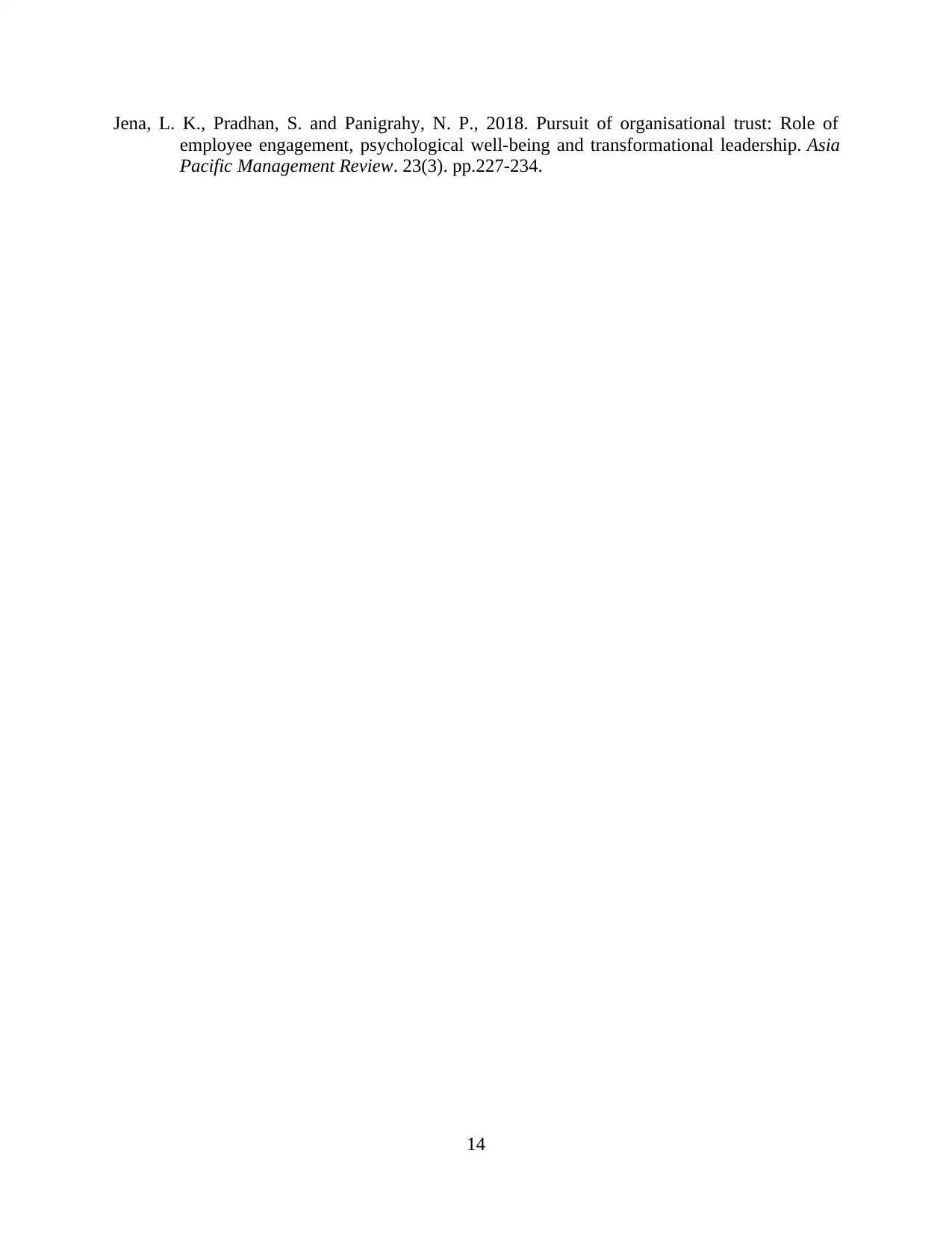
Jena, L. K., Pradhan, S. and Panigrahy, N. P., 2018. Pursuit of organisational trust: Role of
employee engagement, psychological well-being and transformational leadership. Asia
Pacific Management Review. 23(3). pp.227-234.
14
employee engagement, psychological well-being and transformational leadership. Asia
Pacific Management Review. 23(3). pp.227-234.
14
1 out of 16
Related Documents
Your All-in-One AI-Powered Toolkit for Academic Success.
+13062052269
info@desklib.com
Available 24*7 on WhatsApp / Email
![[object Object]](/_next/static/media/star-bottom.7253800d.svg)
Unlock your academic potential
© 2024 | Zucol Services PVT LTD | All rights reserved.





